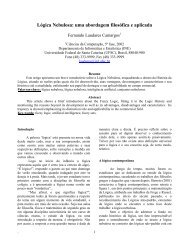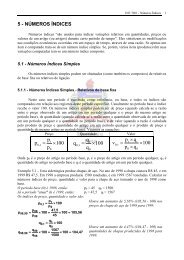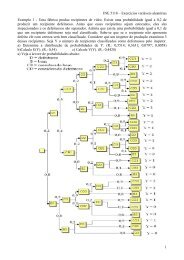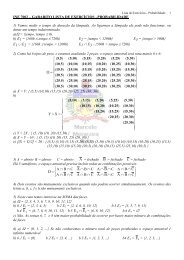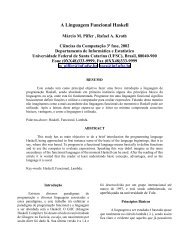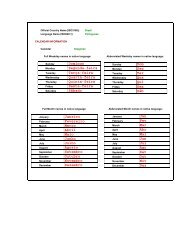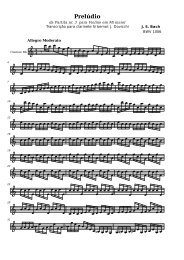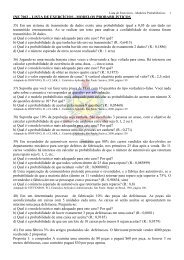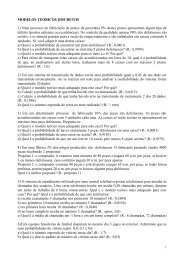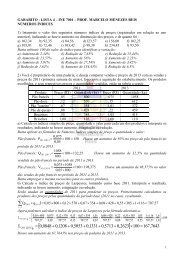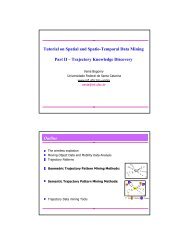Anais do IHC'2001 - Departamento de Informática e Estatística - UFSC
Anais do IHC'2001 - Departamento de Informática e Estatística - UFSC
Anais do IHC'2001 - Departamento de Informática e Estatística - UFSC
Create successful ePaper yourself
Turn your PDF publications into a flip-book with our unique Google optimized e-Paper software.
<strong>Anais</strong> <strong>do</strong> IHC’2001 - IV Workshop sobre Fatores Humanos em Sistemas Computacionais 71<br />
final interface, <strong>de</strong>signers must carefully <strong>de</strong>sign other messages and choose appropriate<br />
channels to convey them, always consi<strong>de</strong>ring the projects’ resources and limitations.<br />
In summary, the fractal communication mo<strong>de</strong>l organises an analysis space which unifies<br />
some current in<strong>de</strong>pen<strong>de</strong>nt practices of <strong>de</strong>sign while brings new issues which <strong>de</strong>serve more<br />
investigation to light. Several questions can be addressed with support of this meta-mo<strong>de</strong>l,<br />
as for example: Are there enough channels and messages to answer to usability questions?<br />
(who are the users, what are the usability problems, how and why they occur)? Do the<br />
messages relative to each question propagate efficiently to the project team? Is there a type<br />
of communication act best suited for the <strong>de</strong>sign of a specific artefact? What are the<br />
consequences of a “broken” propagation resulting from lack of appropriate channel or<br />
message?<br />
A Communicative Walkthrough - an inspection method based on the fractal mo<strong>de</strong>l of<br />
communication is being proposed [23] for systematic analysis of the effectiveness of<br />
communicating usability issues among the groups involved with the product <strong>de</strong>sign and<br />
<strong>de</strong>velopment. Further work is being <strong>do</strong>ne through case studies to evaluate how different<br />
<strong>de</strong>sign approaches fit into the proposed meta-mo<strong>de</strong>l. The possibility of making explicit the<br />
communication levels stressed by the application of a particular technique or metho<strong>do</strong>logy<br />
brings new possibilities of analysing all the elements involved in the <strong>de</strong>sign of computer<br />
artefacts.<br />
The context for <strong>de</strong>veloping off-the shelf products, as is the case at ORG, constrains, up to<br />
some extent, the interaction with users. With the <strong>de</strong>sign of new channels and messages to<br />
collect and to propagate data about what the usability problems are, usability engineers could<br />
make the communication with users much more effective. This view of the organisational<br />
context of software <strong>de</strong>velopment allows to search for continuous improvement in the process<br />
and potentially to <strong>de</strong>velop more usable and useful software.<br />
Acknowleg<strong>de</strong>ments<br />
This work was partially supported by the CNPq and FAPESP.<br />
6. REFERENCES<br />
1. Adler, P S, and Winograd, T A (1992) (eds.) Usability: turning technologies into tools,<br />
Oxford University Press, 1992.<br />
2. An<strong>de</strong>rsen, P B, (1997) A Theory of Computer Semiotics, Cambridge University Press,<br />
Cambridge, UK.<br />
3. Beyer, H B and Holtzblatt, K, (1998) Contextual Design: Defining Customer-Centered<br />
Systems, Morgan Kaufmann Publishers.<br />
4. Brown, G, (1995) Speakers, listeners and Communication, Cambridge University<br />
Press, Cambridge, UK..<br />
5. Coelho Neto, J T,(1996) Semiótica, informação e comunicação, 4ª ed., Editora<br />
Perspectiva, SP Brazil.<br />
6. <strong>de</strong> Souza, C S, (1993) The semiotic engineering of user interface languages, International<br />
Journal of Man-Machine Studies, v. 39, p. 753-773.<br />
7. Ehn, P., Lowgren, J. (1997) Design for Quality-in-use: Human-Computer Interaction meets<br />
Information Systems Development, in: Helan<strong>de</strong>r et al (eds.) Handbook of Human-Computer<br />
Interaction, Elsevier Science.



